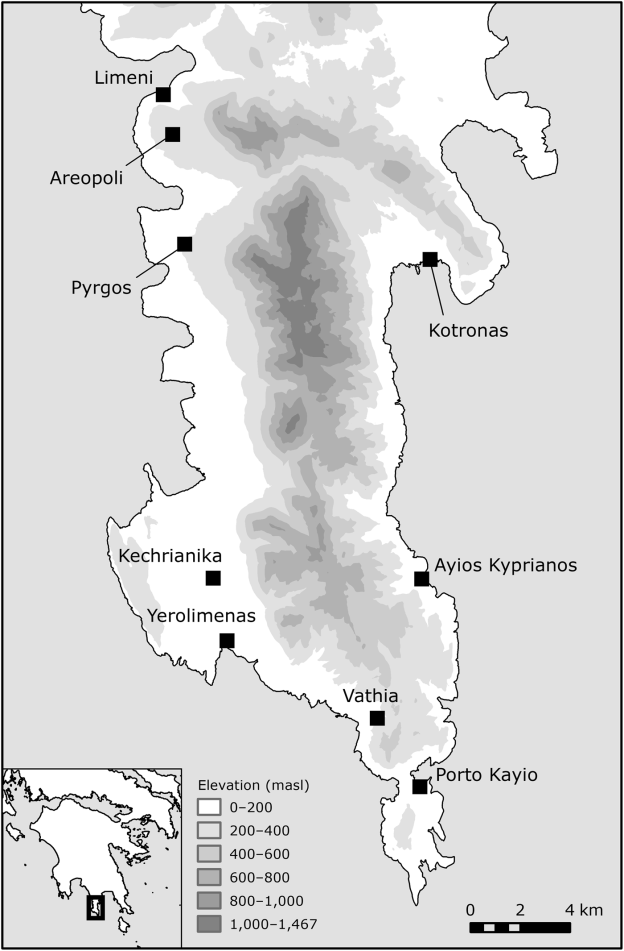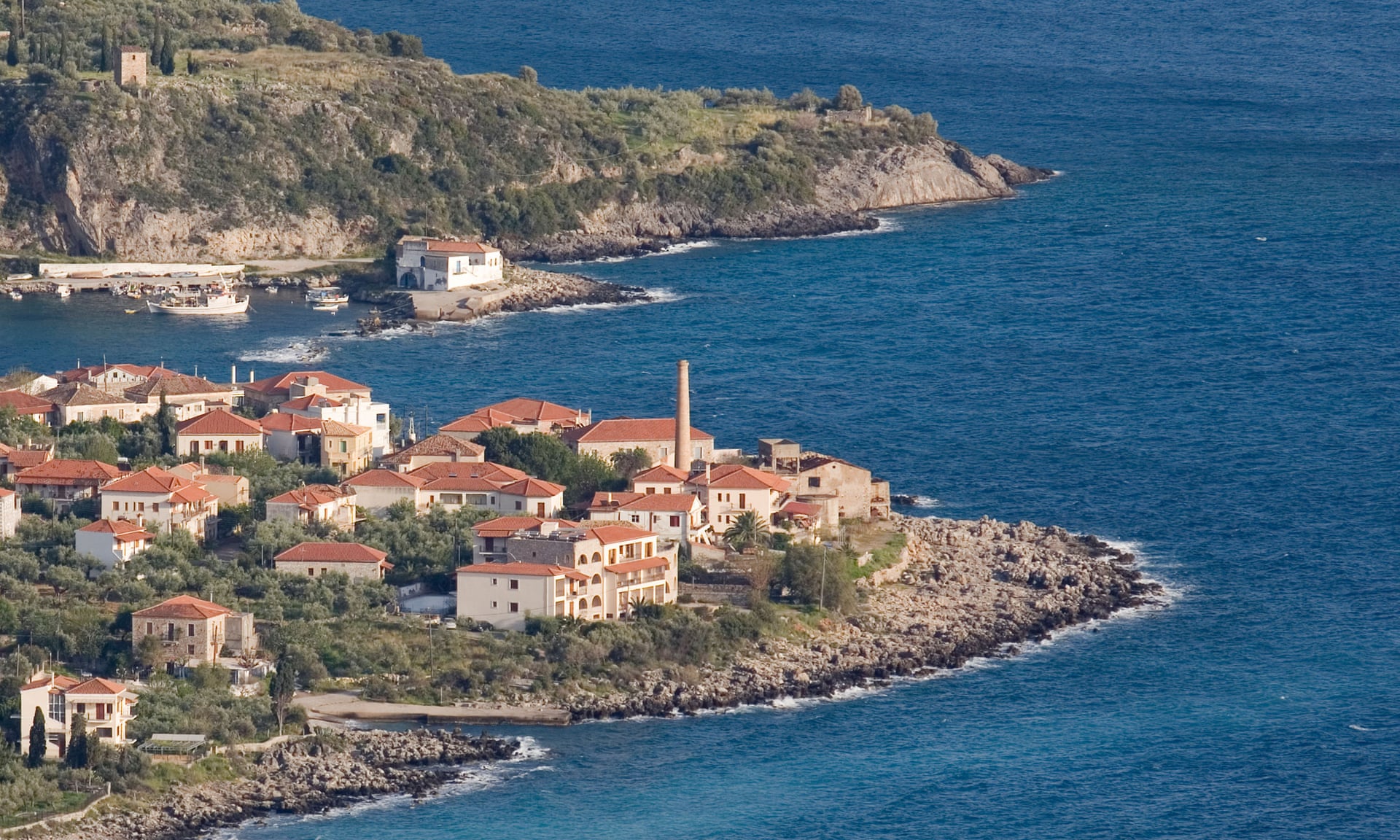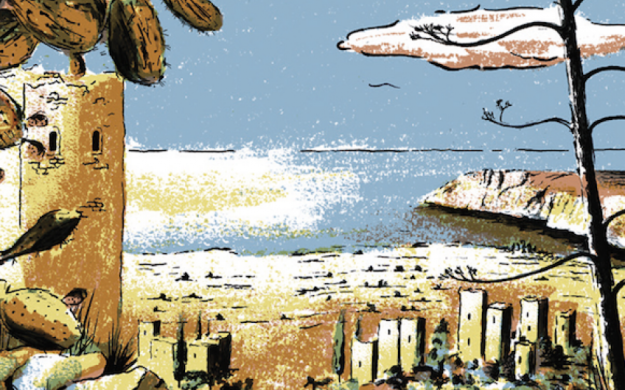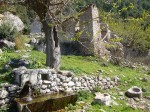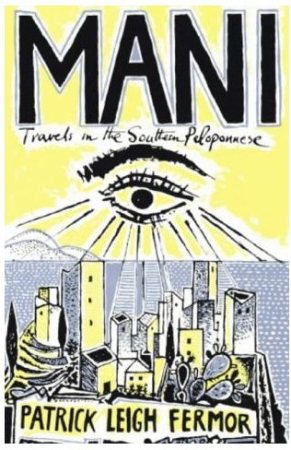Paddy’s observations on the Mani olive harvest, the war stories of old men, and where to find the best olive oil! A Paddy original recently surfaced.
By Patrick Leigh Fermor (unknown provenance sent to me by a friend)
‘Where are you off to? Sit down.’ One of the two cheerful old men, who were smoking crosslegged under the branches, patted the ground beside him. Silvery vistas of gnarled and half-hollow olive trees opened fanwise all round them and there was a cicada grinding and scraping on every branch. A donkey under a wooden saddle grazed a little way off, trailing his long rope through the stubble. A wide hat with green muslin sewn to the brim lay beside one of the old men, and a rusty tin smoke-gun, fitted with primitive bellows that beekeepers fuel with dried dung. He was on his way to his beehives: one of those rows of faded blue wooden cubes that one sees high up in the heather in the summer months.
When I was beside them on the ground and about to light a Papastratos No. 1, the mule owner said: ‘Put it back, boy. Try one of ours from Kalamata.’ I took a Karelia from his packet. He lit it with flint and steel and a long yellow wick and I lay back in an aromatic cloud. It was a baking day with long needles of sunlight piercing the brittle shade of the leaves. The Deep Mani! It had never seemed hotter.
The beekeeper took a pitcher of water out of a little cave among the roots and passed it. I took a long pull of water from the cool and clammy vessel. ‘There’s nothing worse than thirst,’ he said, putting it back. ‘I’ll never forget when we were fighting the Turks on the river Sangarios, the day we captured the mountain of Çatal Dag – you remember, Petro?’ Petro nodded. ‘The confusion was terrible! Our chaps here, the Turks there, dust and smoke everywhere. Dead men, dead horses, wounded men, everyone covered with dust; caps, helmets, fezes – all lost, everything all over the place and upside down! It was a hot August, just like today. And thirst, po, po, po! Never ask! One of our boys who had lost touch with his company, suddenly spied a spring up the mountainside. He ran and flung himself down and started to drink. Then another one arrived and lay down beside him. They made room for each and went on drinking. When they had drunk their fill they sat up and looked at each other with a sigh of contentment. Suddenly our boy realised that the other was a Turk! Panayia mou! A young infantryman, just like him! And, at the same moment, the other realised he was sitting beside a Greek!’ He paused. ‘Just think! A Romios and a Turk, side by side! And the battle still going on all round them. Cannons! Horses! Flags! Shouting! Sabres! Bayonets! Bugles!’
‘Yes, but what did they do?’ The tension was intolerable. Barba Stavro’s eyes were twinkling in their lined sockets.
‘The whistle of bullets – we still had the old-fashioned single-shot Gra rifles then – orders and counter-orders shouted in both languages … mortars, shells, explosions! Wounded and dying all over the place.’ He clicked his tongue. ‘War is a terrible thing!’
‘But what did they do, Uncle Stavro? You are torturing us!’
‘Especially with modern weapons, amán! amán!’ He was gazing into the distance, pensively twisting his white moustache with his forefinger. ‘They say the atom bomb – my granddaughter read me all about it, from the Kathimerini – the last atom bomb, I mean, that they exploded at – what’s the place called? Bikini? – in the Pacific Ocean.’
I seized him by the knees. ‘Yes, but what did they do?’
‘Who? Ah yes, our chap and the Turk … I’m glad you asked …’ There was a long pause. ‘Well,’ he said, taking pity on us at last, ‘they did exactly what you or I would have done. They jumped up and ran away from each other as fast as they could!’
We all laughed. In Albania, in 1941, I asked an old friend what the retreat in Asia Minor had been like, and without hesitation, he said: ‘Like the retreat of the Grande Armée from Moscow, but with sand instead of snow.’ One catches the atmosphere in a flash. It is from the uncomfortable, the haphazard, the comic, that one learns what things were really like.
I wish Anna Comnena had possessed a single spark of these old men’s spirit. But Byzantine chroniclers lacked this blessing: hieratic formality and a slowly fossilising language stifled it; it was beneath their dignity. If Barba Stavro and Barba Petro had been there in 1259, when the Byzantines beat the Frankish army at the Battle of Pelagonia, it would be more than just a date. They would tell us about a Burgundian baron’s charger casting a shoe, or a squabble between two Thracian archers over a plate of beans, and all would be different. Xenophon had the life-giving gift; so did Makriyannis. These old Maniots idling the morning away with me under the hot leaves had it to a supreme degree. The bell round its neck clanked every time the donkey moved to a new patch of stubble, while we were marching in imagination with the Peloponnese Division all over Asia Minor.
These marvellous old men abound, but they will be getting scarce soon. I mean the ones who, in about 1912, received ten years of wars as a coming-of-age present: unambiguous, self-reliant, upright, humorous and philosophical men; weathered by a thousand hardships, and often illiterate, they are equipped with an intelligence that leaves their native simplicity intact. It was in Crete that I first came across these indestructible old men, with their white moustaches and their clear eyes; and, later on, all over rustic Greece and the islands. They gave one a hint of what Kolokotrones must have been like. Nestor, perhaps.
Until that morning, the Asia Minor campaign, which had ended thirty years earlier, had always seemed as remote as the Anabasis. Now, it might have ended last week. Their reciprocal memories egged each other on: the laundry lost in the Meander river … the deaf lance-corporal in Ortaca … Trouble with the town commandant of Süsürlük … Leave overstayed in Smyrna … The over-zealous sergeant-major at Ushak and the confusion caused by his orders, given in mangled Katharévousa.
The tale of a calf ‘acquired’ by a hungry platoon before the battle of Afion-Kara Hissar reminded me of another I had heard a couple of weeks before in the Outer Mani; it had been told me by the hero of the anecdote, who had been on sentry duty at night in a trench as a newly arrived recruit in the Halka Bunar line, in front of Smyrna. I repeated the story: how, all of a sudden, through the darkness, he had heard steps drawing closer from the direction of the Turkish front line. Perhaps it was the spearhead of a night attack! (No password! It couldn’t be one of our night patrols. No answer to my challenge; so I fired. Down went the enemy!) Alerted, the whole front stood to arms, fire broke out all along the line and continued till daybreak, when the raider turned out to be a donkey which had strayed between the two armies. (‘I know the man who told you this!’ Petro said. ‘I’m from the Outer Mani too.’) ‘Ever afterwards,’ the storyteller had concluded, ‘the whole regiment used to tease me about being the heroic donkey-slayer.’ I didn’t tell the story very well, but they laughed politely; and as I finished, the donkey grazing nearby let out a series of desolate brays. Barba Stavro put a finger to his lips: ‘Quieter, Mihali,’ he said. ‘He heard you.’
After a moment, Barba Petro went on. ‘Some people think trees can understand what we say. They like company. At least they like being close to human beings.’ It was an interesting idea. I suggested that it might limit conversation: one didn’t want to corrupt our benefactors. ‘They don’t really hear us, of course,’ he went on. ‘It’s because the trees near to a house always do best. It’s probably all the dirty water the women throw out of the doors, and the mules and donkeys tied up under the branches. Chickens, ducks, pigs, it all helps … And another thing: the trees talk as well as listen!’ He laughed. ‘Do you know what an olive tree says to its master, to help him get a good crop? No? Well, first it says: “When you plough me, you caress me.” Later on in the year it says: ‘When you manure me, you ask me a favour.” But at harvest time it says: “When you prune me, you command me!”’
Throughout this peninsula the olive tree reigns unchallenged. All life revolves round them. They are treated with respect and love: the respect that is accorded to sovereigns and the love that is bestowed on one’s family. Each tree has its personality: every branch and knot and hole is familiar, and to damage one is an unlucky, almost a wicked act; when a plan for the building of a new road or the widening of an old one condemns thousands of them to death, the grief is deep and general. On the eve of such a slaughter I came on a woman wandering among her olives. She had come to say goodbye. ‘They won’t be here tomorrow,’ she said, laying her hand on the rough bark, dry-eyed, but only just. ‘Twenty of them are coming down. I’ve known them since I was a little girl. They were my dowry.’ Next day the destruction began, and on the day after, kilometres of trees lay uprooted to make way for another broad band of asphalt to tear its way through those once silent groves.
I asked my companions how the olives were gathered: did they beat them from the branches with long reeds or poles, as I had seen it done in Crete? They were horrified. Beat them down? Only from the lopped branches on the ground. On the tree itself they were all picked by hand, to avoid bruising the twigs and the shoots: a long task. ‘In some of our Outer Mani villages,’ Barba Petro said, ‘they have started using an instrument like the comb people have for carding wool after the sheep-shearing – it’s just a bit of wood with some nails through it, really, and a handle. It does the work in half the time. You just comb the branches.’
‘Is that so?’ Barba Stavro was as impressed as though he were learned of the discovery of steam power for the first time. When they had discussed it in detail, he turned to me and said: ‘You must come back when they are gathering them. It’s a fine sight.’
I have seen it now. After the first brief rains a note of preparation runs through the Mani; the whole atmosphere begins to change. The blacksmiths hammer away at the great containers which have replaced the old amphorae, and in the olive presses you hear the first trial thumps of the engines which now do the work of the blindfold circling mules. Spraying has delivered the crop from the onslaught of the dacus fly. But the autumn sky has returned to its summer emptiness: ‘Will God rain on us?’ the question goes up. The clouds which at last assemble along the crests of the Taygetus resemble the sails of a relieving fleet after a long siege. At last the first drops fall on the dust like dark scattered stars that soon join and overflow in puddles. By the time it ends, young grass has sprung up in a haze between the tree trunks; sea-squills expand their dark spikes, cyclamen are sprouting among the rocks; and the branches, which have steadily been losing their angular distortion, droop in semicircular arcs under the weight of their berries, like the trees on a willow pattern plate. All has been washed clean and all that the dust and the distance veiled through the hot months leaps forward in glittering detail. Now and then a light wind travels through those thousands of trunks and lifts the pointed leaves so that the silver undersides flicker and flash in the thin November sunlight as though a shoal of millions and millions of fish, prompted by a subconscious mass decision, were changing direction. The ripple dies down and all is still again.
A few mornings later there are sudden voices among the trees after a whole year of silence and the olive groves fill up with figures and animals. Great rectangles of sacking, helped out by a bright blanket here and there, are spread out under each tree in turn like rafts of colour. Ladders ascend into the boughs, the figures group and regroup, men shout from the branches and the women, standing about or sitting in a ring below, beat the lopped and fallen twigs with sticks. The unflagging swish! swish! swish! is the predominant sound all through the harvest. The olives that patter on the cloth like rain are piled in pyramids; children who are too young to be left alone in the empty village chase each other between the trees; dogs bark, mules nibble the new grass and white goats tear the leaves from the stripped twigs that cover the ground.
The women wear their oldest clothes. They are patched again and again, and except for dark pleats and folds that retain their earliest colours, have been faded by the sun and bleached by a hundred washings to pale harmonious hues. Similar groups are assembled in the great level groves; they are scattered on the ascending ledges of terrace that climb until the last trees disperse among the high rocks like puffs of gunfire. The groups, the colours, especially those on the ledges of the perpendicular mountainside, compose themselves like the biblical scenes frescoed on church walls; almost – with the seated and standing figures, the waiting animals and the criss-cross of ladders – into crucifixions infinitely reproduced, except that all is cheerful here. Then men plying their small curved saws at the top of the ladders engage the women beside and beneath them in banter; flocks of girls perch invisibly in cages of leaves. Their songs drift charmingly along the groves. Loaded with bursting sacks and goaded by the cheerful blasphemies of their drivers, strings of mules labour through the dappled light and shade down the lanes to the olive presses; the throb of their engines has suddenly become the heartbeat of all the villages.
Everything gathers here. Animals stamp and neigh and collide and rear, swift hands disentangle them; strong backs are bent double under the sacks. Greetings are shouted and gossip has to be exchanged in voices of thunder to overcome the din of the engine and the roar of the great turning stones. Each peasant watches his cataract of olives poured into the wooden jaws; and when at last the pale jade-green jet of the first oil gushes from the spout below, he dips into it a piece of bread and munches it, feeling the happiest of mortals.
These are private and local scenes, cut off from the outside world. Everyone who doesn’t belong here has fled long ago, at the same time as the swallows. (Not quite everyone, or these lines would not be being written.) One morning there is a confetti of snow on the high peaks of the Taygetus; in a day or two they are an unbroken white, a dazzling background to the oranges with which the village trees are now heavy. The harvesting goes on through the winter solstice until the cut twigs and branches cover the ground and choke the lanes. The aromatic smell of bonfires drifts through the clipped and lightened branches; plumes of pale smoke ascend into the bright air. At night the stars sparkle like icicle splinters. Then the cypresses shudder in anticipation, and the wind comes and drenching rain. Tremendous waves roar up the inlets like an invasion to boom and echo in the caves with which the whole coast is undermined. The waves soar along the cliffs, opening in fans that cover the headlands and offshore islands with canopies of water and foam, to collapse and fall back with a gasp of pebbles. The onslaught reverberates through towers and archways and rooms like the sound of a battle offstage. Nowhere does one feel more cogently the succession of the seasons and the tilt of the earth’s axis. By now every house has its new oil stored in giant containers; the household is safe for another year. The windowpanes are streaming. The stripped trees stretch their roots through the soaking dark red soil; their torpid subterranean energy will cover the branches again by Easter with millions of pale, minute and star-like flowers.
But a shadow falls over these scenes, a small one during that summer day years ago while Stavro and Petro were talking; longer now. For the flight from the Mani continues, and each year the population that gathered the olives grows less. Sometimes, to replace them, troops of women come down from Western Thessaly, strange and fascinating costumes appear in the lanes, the Karagouni accent is heard, even a phrase or two of Koutzovlach. But they are no solution. The great flocks have already vanished from the high summer pastures of the Taygetus. In the north, the brushwood folds of the Sarakatzans, their customs and costumes, and their conical wigwams – those last surviving symbols, perhaps, of the most ancient Greek way of life in the country – have vanished from the Zagora ranges and the Agrapha, and the bells of their flocks sound fainter and fainter every year. Are the olives of the Mani to follow? Some pessimists think so: ‘Where are the hands to harvest them?’ they ask. Where indeed? Ask in Kalamata and Athens, ask in Essen and Düsseldorf, in Duisburg and Cologne and Friedrichshafen, in Melbourne and Adelaide and Sydney; ask in Toronto and Montreal …
Will the day come when the best oil on the planet ceases to flow; when the silver cord is loosed, as in the last chapter of Ecclesiastes, and the grinders cease because they are few and the doors shall be shut in the streets?
The best oil on the planet. Stavros and Petro had no doubts about it. We all agreed that Greek olives were the best. I said, ‘What about Amphissa?’ They turned on me with pitying tones. No, no. The Mani was the place. But where in the Mani? ‘Here!’ Stavro said. His forefinger, which was as hard as a goat’s horn and nearly as wrinkled, gave the ground a gnomic tap. Then he gathered his beekeeping gear and got up, stretching himself and yawning. ‘We’ll go home and try some. And swallow an ouzo or two to revive us after our labours.’ We all laughed; we were streaming with sweat, but not from toil. We had lain there talking for more than three hours. Petro collected his mule, which had wandered away some distance.
‘Stavro,’ he said as we set off. ‘Deep Mani olives are good. I’m not saying they’re not. But the best are the ones in the Outer Mani. The whole world knows it. It’s not just because I come from those parts – far from it. But it’s everybody’s opinion.’
‘So be it,’ Stavro said. He gave me a secret dig with his elbow and the ghost of a wink. I asked Petro where the best in the Outer Mani come from. ‘From Liasínova,’ he answered without hesitation. There was a scarcely audible chuckle from Barba Stavro. I asked Petro where he came from. ‘Me? You mean where do I come from?’ Then, in airy tones of slight surprise at the unexpected coincidence, he said: ‘From there. From Liasínova, that’s to say.’
It was a splendid illustration of local prejudice. But now, after many years and mature consideration, I think there was a lot in what he said. Certainly, the best olives in Greece come from the Outer Mani; and definitely from the region of Liasínova. But from Liasínova itself? I think a truly impartial and objective opinion might place the actual pinpoint of unsurpassable excellence a little further down the coast – only three or four kilometres away. More towards Kardamyli, perhaps.
Editor Note: Since publication some of you have come forward with ideas about the source of this. I like the one from Pietro Basile best:
Hello Tom,
here’s the current source for Swish, swish, swish.
Apparently it was written for a Greek edition of Mani but never published.
No mention of who found it, but great piece, if one actually actually knows Greece.
My guess is that he wanted to have it it included as a special homage to his area but whoever was the editor thought it was a bit corny…
Regards,
Pietro
